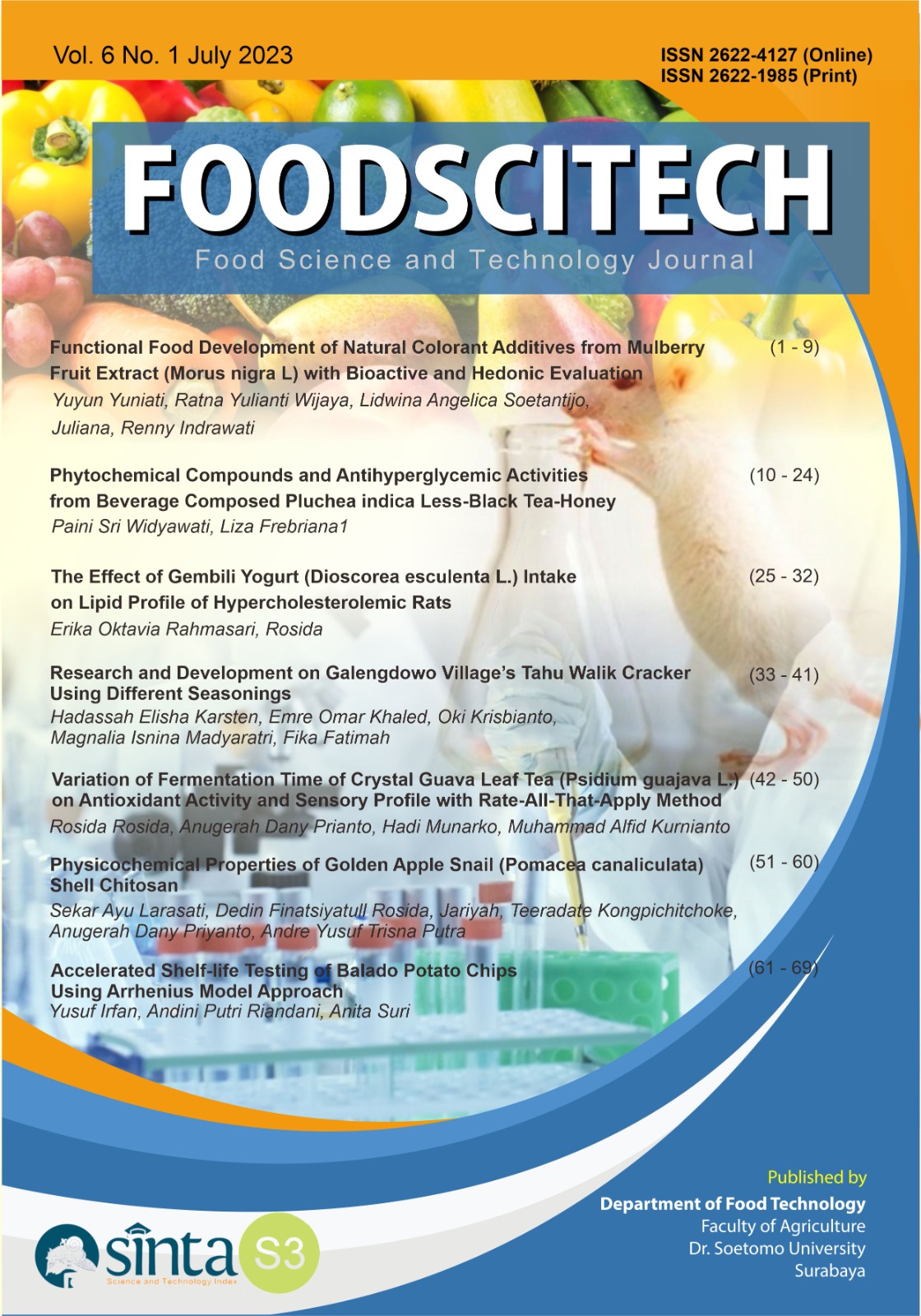Main Article Content
Abstract
Tahu walik is a snack product originating from Banyuwangi but has been developed in other areas such as Galengdowo Village, Jombang. To develop Galengdowo's tahu walik products that were able to compete inmarket, it was necessary to conduct research related to product sensory and consumer acceptance. The five sample variants used in this study were tahu walik without seasoning (T0), original seasoning (T1), balado seasoning (T2), salted pepper seasoning (T3), and commercial tahu walik (T4) for comparison. A total of 40 panelists conducted a hedonic analysis of the product's appearance in the packaging, shape, color, crispness, taste, and oily. The results showed that the highest purchase motivation was seen in T1 and T2, which were reddish, while the assessment of the packaging and sample's shape was not significantly different. The crispness value of T0 was the lowest compared to the other four samples which were not significantly different. Panelists most liked the taste of T3, T2, and T4 while T0 was the lowest, while the oily feeling was felt the most in sample T0 and the lowest in T2. Based on Simple Additive Weighting, T2 has the highest rank while T0 is the lowest. The difference in the type and color of the seasoning greatly influenced the panelists' preferences and their decision to buy tahu walik products. It can be concluded that the tahu walik processing industry in Galengdowo Village needs to develop its products to increase competitiveness in the market.
Keywords
Article Details

This work is licensed under a Creative Commons Attribution-NonCommercial-ShareAlike 4.0 International License.

This work is licensed under a Creative Commons Attribution-ShareAlike 4.0 International License.
References
- Arifin, R., Ningsih, A. A. T., & Putri, A. K. (2021). The Important Role of MSMEs in Improving the Economy. South East Asia Journal of Contemporary Business, Economics and Law, 24(6), 52-59.
- Augustian, B., Jessica, C. N., Enrico, C., Nasri, K., Utami, N. W., Hoetama, P., Widjaja, S., & Marchalina, L. (2019). Faktor-Faktor yang Mempengaruhi Konsumen dalam Pembelian Jajanan Tahu Walik di Kota Cianjur. Jurnal Pemberdayaan masyarakat, 1(2), 366-378.
- Badan Standardisasi Nasional. (2006). SNI 01 2346-2006: Petunjuk pengujian organoleptik dan atau sensori. Badan Standardisasi Nasional.
- Bukhari, S. F. H., Woodside, F. M., Hassan, R., Hussain, S., & Khurram, S. (2022). Exploring the motives behind the purchase of western imported food products. A phenomenological study from a Muslim-dominated region. Journal of Islamic Marketing, 13(2), 481-507.
- Duguma, S., & Abebaw, G. (2020). Quality Assessment of Oil Used for Frying of Potato Chips: In the Case of Wolkite University Community. American Journal of Bioscience and Bioengineering, 8(5), 92-98.
- Erliana, K., & Wibowo, R. (2020). Perancangan Kemasan Produk Tahu Walik Dengan Metode Quality Function Deployment (Studi Kasus Home Industry Tahu Walik Lawang). Jurnal Penelitian dan Aplikasi Sistem & Teknik Industri, 14(1), 96-104.
- Garber, Jr., L. L., Hyatt, E. M., & Starr, Jr., R. G. (2000). The Effects of Food Color on Perceived Flavor. Journal of Marketing Theory and Practice, 8(4), 59-72.
- Hamimi, Tamrin, dan Setyani, S. (2011). Uji Kinerja Mesin Peniris Minyak Goreng pada Pengolahan Keripik. Jurnal Teknologi & Industri Hasil Pertanian, 16(1), 91-100.
- Hutchings, J. B. (2011). Food Colour and Appearance (2nd ed.). New York: Springer.
- Iffathurjannah, M. I., & Harti, H. (2021). Pengaruh keamanan makanan, harga dan rasa terhadap keputusan pembelian. AKUNTABEL, 18(2), 235-246.
- Maina, J. W. (2018). Analysis of the factors that determine food acceptability. The Pharma Innovation Journal, 7(5), 253-257.
- Moser, A. & Korstjens, I. (2018). Series: Practical guidance to qualitative research. Part 3: Sampling, data collection and analysis. European Journal of General Practice, 24(1), 9-18.
- Prasasti, M. E. & Santoso, A. D. (2022). Upaya Meningkatkan Ekonomi Masyarakat Desa Sedang di Masa Pandemi Covid-19 melalui Inovasi Pembuatan Tahu Walik. Jurnal QIEMA, 8(1), 1-6.
- Prasetyo, P. E. (2021). The Role of MSME on Unemployment in Indonesia. Turkish Journal of Computer and Mathematics Education, 12(13), 2519-2525.
- Pratisti, C., Sari., N., Paramitasari, N., & Wahyuningsih, Y. (2002). Pelestarian dan Strategi Pemasaran Produk Wisata Tahu Walik Khas Banyuwangi dimasa Pandemi Covid 19. Jurnal Mulia, 1(2), 41-49.
- Pusat Data dan Sistem Informasi Pertanian. (2021). Buletin Konsumsi Pangan (Vol. 12). Jakarta: Kementerian Pertanian.
- Quek, M. C., Chin, N. L., & Tan, S. W. (2021). Optimum DNA Extraction Methods for Edible Bird’s Nest Identification Using Simple Additive Weighting Technique. Foods, 10, 1086.
- Rebane, T. (2018). Complementarities in Performance between Product Innovation, Marketing Innovation and Cooperation with Clients. Tartu: The University of Tartu.
- Serawati, I. D. & Putri, D. O. (2019). Strategi Pemasaran Produk Kuliner Tahu Walik. Journal of Industrial View, 1(2), 14–21.
- Sukardi, S. (2021). Analisa Minat Membaca Antara e-Book dengan Buku Cetak Mengunakan Metode Observasi Pada Politeknik Tri Mitra Karya Mandiri. IKRAITH-EKONOMIKA, 4(2), 158-163.
- Wirahayu, Y. A., Purwito, H., & Insani, N. (2019). Community-based tourism management in Santen Beach, Banyuwangi. IOP Conf. Series: Earth and Environmental Science, 243, 012059.
- uliarti, O. (2020). Textural Characteristics of Indonesian Foods. In K. Nishinari (Ed.), Textural Characteristics of World Foods (pp. 137–150). West Sussex, UK: John Wiley & Sons.
